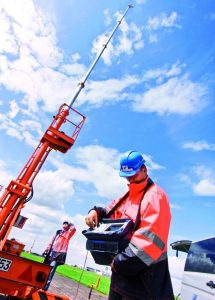ROHDE & SCHWARZ ADOPTS OIL-FREE TECHNOLOGY FROM COMPAIR
 Rohde & Schwarz GmbH & Co. KG has embarked on a programme to upgrade its compressed air supply to CompAir’s oil-free, DH compressors at its main production plant in Memmingen (Germany).
Rohde & Schwarz GmbH & Co. KG has embarked on a programme to upgrade its compressed air supply to CompAir’s oil-free, DH compressors at its main production plant in Memmingen (Germany).
The aim was to improve production reliability, while at the same time reducing compressed air costs and the company has already achieved these targets, with fast payback and improved efficiency.
Application Details
Rohde & Schwarz develops and manufacturers complex devices for wireless and measurement technology, with more than half of the world’s mobile phones checked by the company’s measurement systems.
A key application at the company’s main plant in Memmingen is the manufacture of electronic components. Here, state-of-the art pick and place machines are used to convey these components pneumatically.
This requires a large quantity of compressed air, which must be oil-free air to avoid any damage to the sensitive valves on the conveyor system. Oil-free compressed air is also used to blow the PCB boards clean after production.
Compressed air quality
At Rohde & Schwarz, compressed air quality is monitored closely. Previously, the company used oil-lubricated compressors to produce its compressed air, using a system comprising an adsorption dryer, activated carbon adsorber and filter combination.
However, this was costly, as around 20% of the compressed air produced was required for the regeneration of the adsorption dryer.
Alfred Ahon, who is responsible for manufacturing technology projects at the Memmingen plant and therefore, for renewing the compressed air supply, says, ‘We continuously measure the residual oil content of the compressed air produced and record the value. We react immediately if discrepancies occur.’
The introduction of oil-free
When the purchase of an additional pick and place line was being considered, it became apparent that the compressed air supply would reach its capacity.
For Alfred Ahon it was clear that investment in new technology should not only increase air availability, but also reduce compressed air costs and further improve production reliability.
A completely new air network could not be considered at this stage, but gradual transition to oil-free air production was to be introduced with the installation of a new compressor.
As a result, Rohde & Schwarz opted for a DH oil-free compressor from CompAir.
Very high efficiency
CompAir’s DH compressors have a different operating principle to conventional oil-free screw and piston compressors and operate without any oil lubrication.
The compressor block is lubricated, sealed and cooled by water, which is sprayed into the compression element. Water’s excellent cooling properties allow the compressor to be operated at low compression temperatures not exceeding 60oC. The result means the compressor is highly efficient, while the power consumption is correspondingly low.
The gearless drive train also improves energy efficiency. The electronic control system performs the tasks of a mechanical gearbox, which means many mechanical components which are prone to wear can be dispensed with – another plus point when it comes to cutting overall costs.
Energy-efficient processing
A new energy-saving adsorption dryer with a heat recovery system and an activated carbon adsorber were acquired along with the compressor.
The existing refrigerant dryer is being used to pre-dry the compressed air, which as Alfred Ahon explains, ‘means we can reduce the load on the adsorption dryer and extend the service life of the adsorption agent.’
A sound investment
Alfred Ahon concludes, ‘The extra investment costs pay for themselves through lower energy consumption and reduced maintenance expenditure.
‘Previously, we changed the adsorption agent every year, because the residual oil content increased. Now we only expect to make a change once every two and a half years and the service life of the filters has also more than doubled.’
The new compressor produces around 70% of the compressed air required – to the company’s complete satisfaction.
